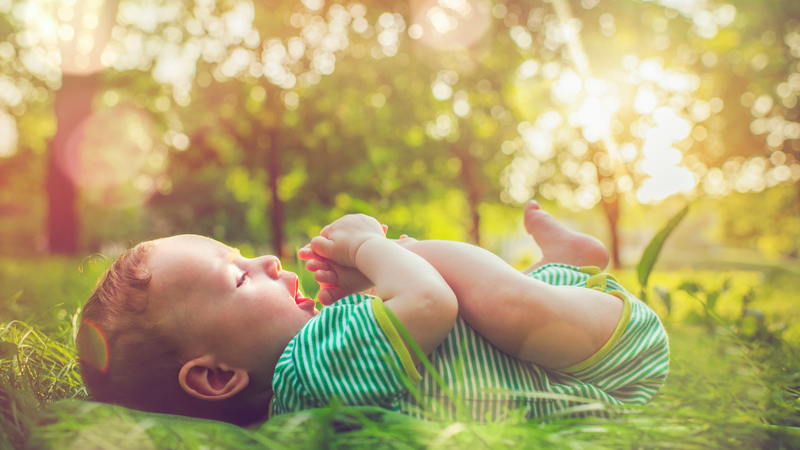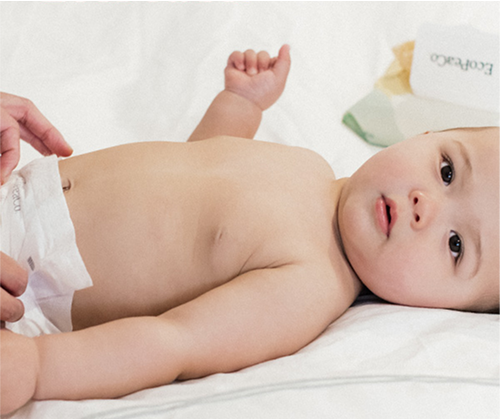Babies are known for their super smooth, super soft skin. The only downside? Sometimes that skin can be prone to rashes and other uncomfortable conditions. This often shows up as baby eczema on their face. Infant eczema, also called atopic dermatitis, is an inflammation of the skin commonly composed of dry skin patches on the faces of babies with sensitive skin. These patches can be incredibly itchy and uncomfortable.
Luckily, by getting to know more about newborn eczema, what causes it, and how to treat it, you can help your baby overcome this common skin ailment.

What does baby eczema look like?
Something important to keep in mind about baby eczema is that it doesn't look the same on every baby. For example, on babies with lighter skin, newborn eczema usually looks like patches of red skin. On babies with darker skin, these patches might be purple, brown, or gray in color, and can be harder to notice.
A commonality among most of these skin patches is they’re typically dry, itchy, and rough.
While babies can get eczema anywhere on the body, it commonly shows up on the face and the joints of their arms and legs. Some parents confuse facial eczema with cradle cap, as they can look similar; however, cradle cap isn’t typically itchy and usually appears on the scalp, whereas newborn eczema usually appears on the cheeks.
Baby eczema can look different at various ages:
- Eczema in zero- to six-month old babies: Usually appears on the face, cheeks, chin, forehead, and scalp. Skin can look very red and moist.
- Eczema in six- to 12-month-old babies: Shows up more on the elbows and knees, usually areas impacted by scooting or crawling. When the dry skin patches are infected, they can develop a yellow crust, or small pus-filled bumps.
- Eczema in two- to four-year-old toddlers: Usually appears in the creases of the elbows and knees, or on the wrists, ankles, and hands. It can also show up around the mouth and eyelids. The rash can look dry and scaly, and become thick with deep lines.
- Eczema in children five years and older: If an older child develops eczema, it’s most likely to appear in the folds of the elbows or knees, or on the hands.
What causes baby eczema?
Eczema occurs when the body makes too few fatty cells, called ceramides, causing the skin to lose water and become incredibly dry. There are a few potential reasons for this reaction.
- Genetics: If one parent has eczema, your baby has a higher chance of developing it. Babies with a family history of asthma or hay fever are also more likely to develop eczema.
- Issues with the skin barrier: If there are issues with your baby’s skin barrier, more airborne allergens may be able to enter the skin and cause irritation.
- Food allergies: Foods like cow’s milk and eggs can cause an allergic reaction that sometimes results in eczema.
- Reaction to an irritating substance: Shampoo, body wash, and sunscreen used on the skin might contain ingredients that irritate the skin and trigger eczema.
Your baby’s pediatrician can help you determine why your child might be experiencing newborn eczema.
What can make eczema worse?
In addition to knowing the potential causes for eczema, understanding the factors that can exaggerate this skin condition can help you minimize your baby’s discomfort.
- Dry environments: Being in environments that can dry out your baby’s skin can make eczema worse. Many babies develop more severe cases of eczema in the winter, when the air indoors is incredibly dry because of the use of heaters.
- Heat: Being hot and sweaty can aggravate eczema.
- Certain irritants: Fabrics like wool and polyester, and products like soap and laundry detergent (especially scented), can inflame eczema.
- Stress: Stress can worsen eczema, as it can cause the skin to flush.
Limiting baby’s exposure to these factors, and being hyper-vigilant about protecting their skin, can help prevent their eczema from intensifying.
What’s the difference between baby eczema and dermatitis?
Parents are commonly confused about the difference between baby eczema and dermatitis, and for good reason. Both the terms “eczema” and “dermatitis” are used to describe inflammation of the skin. The term “atopic dermatitis” is used to describe the type of eczema that can impact people under the age of 18. This is the medical term for baby eczema, and describes a chronic skin condition that is caused by an overactive immune response to triggers inside and outside the body.
Essentially, not all types of dermatitis are the same as baby eczema, but “atopic dermatitis” and “baby eczema” are the same thing.

How to Treat Eczema on a Baby’s Face?
Now that you know common causes for eczema, and what it looks like, you can help your baby avoid circumstances that might trigger eczema. However, there will still be times when an eczema flare up might be unavoidable. In those situations, the following baby eczema treatments can help.
- Keep baby’s skin moist: Eczema thrives in dry conditions, so it’s best to keep your baby’s skin as hydrated as possible. Apply a baby-safe moisturizer (fragrance-free) throughout the day, especially after a bath. Moisturizers that contain ceramides can be especially helpful, and are typically available over-the-counter, or with a prescription. Good natural moisturizers include coconut oil, shea butter, and aloe vera. Products that contain calendula, honey, and oat ingredients are also soothing.
- Give baby a short, lukewarm bath: Hot water can dry out the skin, so it’s best to bathe baby in lukewarm water, especially when they’re having an eczema flare up. Keep the bath under 10 minutes. You can enhance the soothing effects of the bath by adding an oatmeal-based bath soak treatment to the water.
- Use soap sparingly: Only use soap on areas that are more prone to getting dirty, like their genitals, and creases in the skin.
- Gently dry baby: Pat baby’s skin dry instead of rubbing it with a towel, since rubbing can agitate eczema.
- Avoid products that contain irritants: Opt for products that are free of fragrances, alcohol, dye, sodium lauryl sulfate, essential oils, urea, cocamidopropyl betaine, propylene glycol, parabens, and methylchloroisothiazolinone.
- Wash new clothes first: New clothes might contain irritants, so it’s best to wash them with a gentle, fragrance-free laundry detergent before putting them on baby.
- Dress baby in loose, breathable clothing: Being hot and sweaty can inflame eczema, so choose clothing that allows baby’s skin to breathe. Organic cotton, linen, silk, and hemp are great options. And because fabric rubbing on baby’s skin can also make eczema worse, ensure their clothing isn’t too tight.
- Trim baby’s nails: Scratching can make an eczema rash worse, so keep baby’s nails short. Parents can also put “scratch mittens” on the baby’s hands.
- Look at your diet if breastfeeding: If your baby gets most of their nutrients from breast milk, it’s important to consider what you're eating. When you're eating a diet rich in fruits, vegetables, fish, and Vitamin D, your milk might actually reduce the eczema. Some foods to potentially stay away from include cow's milk, peanuts, tree nuts, and shellfish.
Can you put eczema cream on a baby’s face?
In addition to the above baby eczema treatments, you can also use certain baby eczema creams on baby's face. A few things to keep in mind when finding the right product to use:
- Creams are usually better than lotions and ointments.
- Opt for a thicker cream that creates a barrier on the baby’s skin.
- Use a cream that contains ceramides and is fragrance-free.
- Use a hypoallergenic cream.
- Avoid creams that contain synthetic fragrances, parabens, phthalates, or artificial coloring.
You might need to use a variety of creams until you find the right fit. If it’s not making the rash worse, try a cream for at least two weeks to see how well it works.
How long does eczema take to clear up?
Typically, an eczema flare up lasts one to three weeks if it’s being properly treated, but can unfortunately stick around for months. It’s also important to note that atopic dermatitis is a chronic disease, meaning that it never fully leaves the body. However, it can go into remission for weeks, or even years, during which time the person has no symptoms.
The main takeaway is that there’s no way to know for sure how long eczema will last, but vigilant care of the rash can significantly reduce discomfort, and even help it go into remission sooner.
When to call a doctor
If the rash doesn’t get better after about a week of beginning baby eczema treatment, or if it's is causing your baby significant discomfort, it’s best to alert their pediatrician. If you’re not sure that a rash is eczema, you’ll want to take the baby to the doctor to ensure they receive the right diagnosis. In some cases, the doctor might need to prescribe medication.
You should also call your doctor if the newborn eczema develops a yellow or light brown crust, or pus-filled blisters appear on top of the eczema, as this could be a sign of a bacterial infection.
While baby eczema can be an alarming development, there are many ways to soothe flare ups, and help ensure that your baby’s eczema is triggered as little as possible. As you navigate this skin condition, it’s important to remind yourself that you did nothing to cause it – this is a common issue that impacts many babies and is easily treatable.


